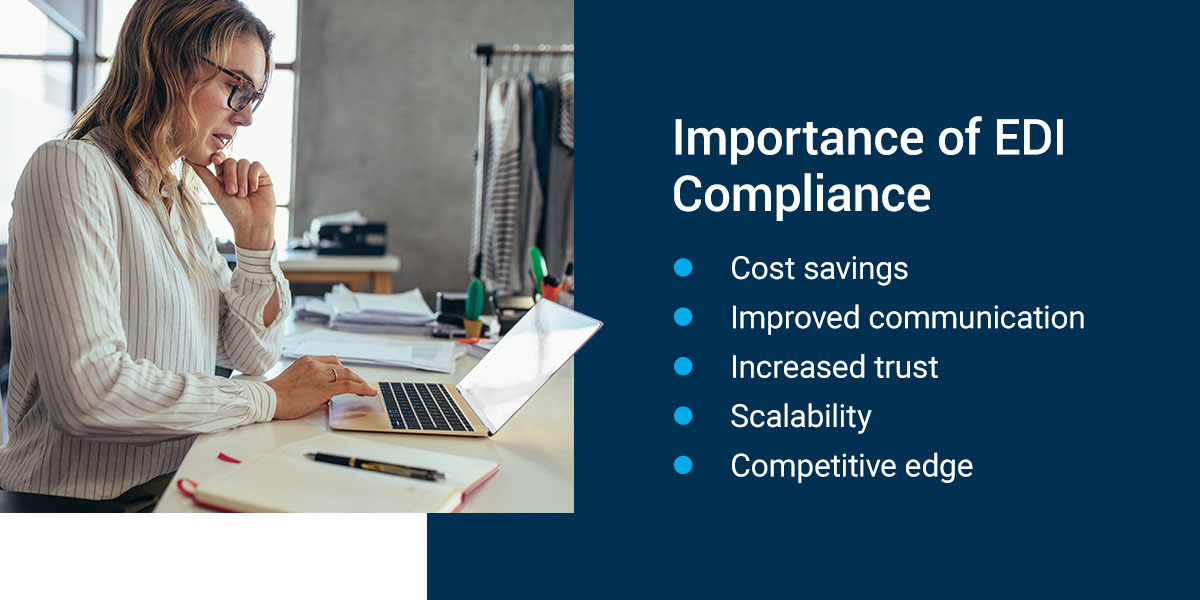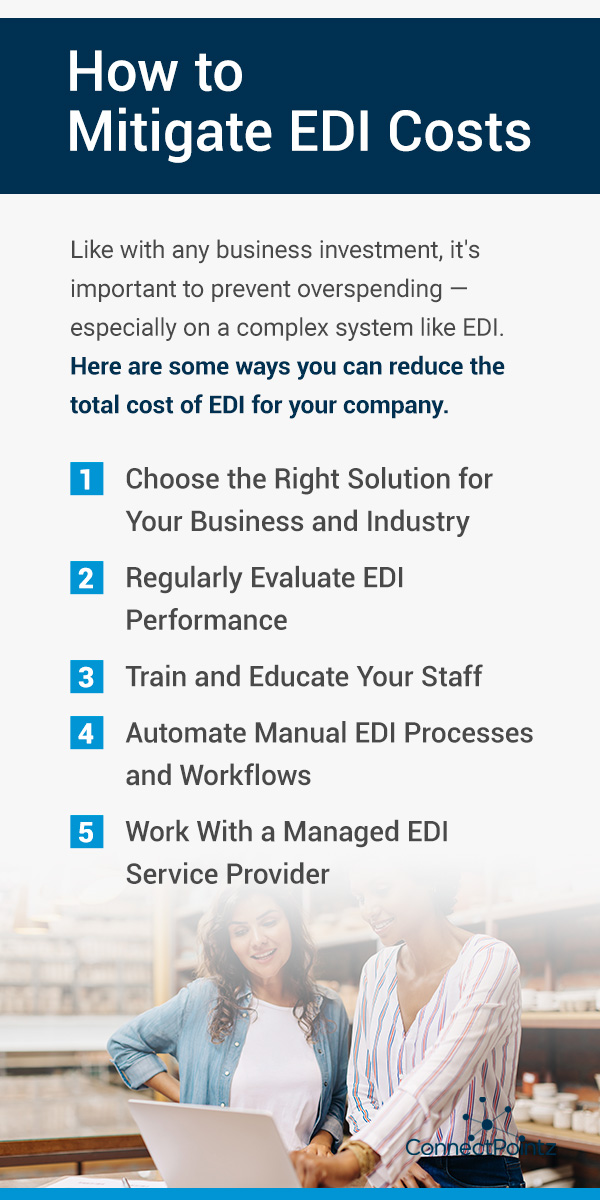How Much Does EDI Cost?
Electronic data interchange (EDI) technology has come a long way since its origin as standardized shipping manifests. Today, it's a foundational element in business communication for many companies around the world — and it's becoming increasingly important for small- and mid-sized businesses.
Implementing an EDI system in your business can help you save valuable time and money by streamlining operations and facilitating rapid long-distance communication, but you need to ensure your EDI solution works for your company's budget. Understanding what goes into determining your EDI system cost can help you make the most informed decision.
Overview of EDI Implementation
Here's a quick breakdown of the implementation process:
- Organizational analysis: Perform an in-depth analysis of your existing business structure to determine where your organization would most benefit from EDI implementation. Typically, these areas will be where you experience the most inefficiencies, such as tedious data entry tasks where human error is a concern.
- Specifications list: Drafting a comprehensive list of the needs you identified in the previous step helps determine your required system specifications, which enables your software provider to build a specialized solution for your organization. Some important items to note include your internal network capacity, expected traffic and the level of customization you require.
- Vendor selection: If you are planning to leverage managed EDI services, you'll want to choose a reliable EDI vendor with demonstrated experience in your industry — this knowledge will ensure they understand the specific compliance requirements your business will have to follow.
- EDI integration: Install your new EDI software, then extract and upload your existing data to the system. Typically, this step requires a lot of file conversion and software configuration, so it's important to have a reliable EDI transition expert on your team to guide you through it.
- Training: Training your internal teams on the new data structure and processes sets your organization up for lasting success. Ideally, your vendor will offer training and support services for their EDI solutions.
- Data mapping: This step involves connecting your data to the required EDI standards for your industry to ensure it is organized and accessible. EDI translation software is usually necessary for data mapping to work.
- Test run: Running a pilot project with select business partners helps ensure the system works properly so you can eliminate any remaining issues before rolling it out to the rest of your organization.
- Roll out: Once you've completed a successful pilot, it's time to roll the solution out to your remaining business partners. Enlisting the help of an EDI expert will be invaluable for ensuring a smooth transition.
The process is very similar if you choose to design your own internal solution.

Importance of EDI Compliance
Each industry has specific compliance requirements for EDI transactions — for example, the Health Insurance Portability and Accountability Act (HIPAA) mandates health care organizations to use a specific set of EDI standards for formatting, sending and storing electronic patient health information (ePHI). Similarly, most major retailers require their vendors to follow their own EDI guidelines.
The primary benefits of EDI compliance include:
- Cost savings: EDI lets you automate repetitive manual work, such as data entry and processing, so you can reduce unnecessary costs resulting from process inefficiencies. Additionally, EDI software digitizes your transactions so you can cut down on paperwork.
- Improved communication: Adhering to your business partners' EDI standards helps maintain seamless, accurate communication between parties, which is essential for efficient operations and reducing errors.
- Increased trust: EDI compliance demonstrates your company's commitment to efficiency, which can enhance your business's reputation as a reliable trading partner.
- Scalability: As your business grows, you'll need to complete more transactions in your day-to-day operations. Adhering to relevant EDI standards for your industry can help make it easier for your system to handle a higher volume of transactions, so you can scale operations without significant price hikes.
- Competitive edge: Many companies — especially large corporations and government agencies — actively seek out EDI-compliant partners, so implementing a compliant system can help you grow your business and reputation within the industry.
Failure to comply with EDI standards can result in costly chargebacks, also known as “expense offsets.” Many corporations enforce a chargeback policy to offset the costs associated with noncompliant transactions. For example, if a customer receives an incorrect ship notice (EDI 856), they won't be prepared to receive the shipment when it arrives, which can significantly disrupt operations and cost them hundreds or even thousands when they need to make a return. Charging your company in response helps recuperate some of those costs.
How Much Does EDI Cost?
Ultimately, the costs associated with implementing and using an EDI system depend largely on your industry and your business's unique requirements. For example, the EDI needs of a mid-sized logistics company and a large healthcare organization are completely different — and their EDI costs will reflect that.
Understanding each component of your total EDI cost can help you develop a rough estimate of the kind of costs you may be looking at.
How Much Does EDI Software Cost?
The upfront EDI system cost — which includes your initial software purchase as well as any additional fees associated with training and installation services — depends on whether you decide to design your own in-house solution or outsource to a third party. An on-premises in-house system is usually the most expensive option unless you already possess the infrastructure and expertise to support it. Third-party solutions are often easier to include in your budget, but you'll also need to consider that you will depend on your vendor for maintenance and updates.
Industry-specific value-added EDI networks (VANs) are another important consideration for companies in highly regulated industries like health care and manufacturing. A VAN expands the standard EDI service offerings to include data integrity and security features like encryption.

How Much Does EDI Cost to Implement?
The biggest contributors to your EDI implementation cost are your business size and EDI requirements — for example, how much data you will need to convert during integration. Generally speaking, the more extensive your business needs, the more you'll have to pay for implementation services.
If you're developing your own solution, your internal team will be responsible for managing implementation. While this arrangement can work well for companies that have large software teams, smaller organizations may have difficulty successfully implementing the system on time, which can result in additional costs.
How Much Does EDI Cost Per Transaction?
Each EDI vendor uses a different pricing model, so you'll want to make sure you understand which model you'll be working with before you sign on.
Many managed service providers base their EDI fees on the number of transactions — or documents — your company makes in a fixed period of time. More specifically, they charge you based on the number of kilo-characters in a document. For example, a transaction containing 5000 characters, or five kilo-characters, might cost 50 cents. And a transaction containing one kilo-character would cost 10 cents.
Managed EDI services usually follow one of the following pricing models:
- Pay-as-you-go (PAYG): Transaction volume directly impacts your subscription costs — the more documents you create, the higher your usage costs will be. This pricing model provides flexibility for businesses in industries that frequently experience demand fluctuations, such as retail and manufacturing.
- Monthly subscription: Your provider will charge you a fixed price each month based on the service tier you choose. As your business grows, you can upgrade to the next highest tier to gain access to additional network resources.
- Annual subscription: Your provider will charge you a fixed lump sum for the entire year, often at a discount. An annual subscription is helpful when budgeting for the year, as it is a predictable one-time cost you can account for right away.
Other providers charge based on the number of trading partners you want to work with. So while you may start at a base rate for five partners, your costs will increase as you add more partners.

How to Mitigate EDI Costs
Like with any business investment, it's important to prevent overspending — especially on a complex system like EDI. Here are some ways you can reduce the total cost of EDI for your company.
1. Choose the Right Solution for Your Business and Industry
Some highly specialized companies implement their own internally developed EDI solution, which gives them more flexibility to customize the system to meet their unique needs. However, for many businesses, this option is out of their budget or capabilities.
There are lots of EDI companies out there, each with its own unique service propositions and pricing schemes. Finding one that makes sense for your organization is essential if you choose to outsource, as you'll be starting a lasting business relationship.
Here are some key characteristics to look for in an EDI solution:
- Cost-effective: Carefully consider how well a solution fits into your budget, taking into account all associated fees and ongoing expenses. Getting comprehensive quotes before choosing a provider is essential to prevent overspending.
- Scalable: How easily can you scale the software to accommodate increases in document volume and user traffic, and how will this change affect your pricing? It's important to ask your provider for clarification here.
- User-friendly: New software typically comes with a steep learning curve for your staff, which often causes a costly period of inefficiencies and errors as team members adjust.
2. Regularly Evaluate EDI Performance
Monitoring and routinely auditing your EDI system can help you identify and resolve issues that could be impacting its overall performance, like process errors or gaps in your data sets. Visualization tools like reports, dashboards and logs are especially useful tools, as they can help illustrate important trends in current and historical data for easier evaluations. Benchmarks and KPIs can also be helpful metrics for assessing your organization's improvement over time.
Many vendors include some or all of these capabilities in their software, so be sure to keep them in mind when weighing out your options.
3. Train and Educate Your Staff
The longer your team has to spend learning how to use your new software, the slower your ROI will be. Taking advantage of training opportunities is essential for a smooth implementation.
Ensure your entire EDI team knows and understands the relevant best practices, standards and procedures for your system so they can use it most effectively. Training your staff on your system during or shortly after implementation is the best time to start, then offer refresher courses every few months to years to keep their knowledge up to date.
Start by checking with your EDI software provider to see if they offer training services for clients' internal teams — because they know their technology best, their staff will be the best resource for educational materials. They may also provide resources for ongoing education, such as online courses, product manuals, webinars and guides, which can be helpful for retaining the knowledge after training.
4. Automate Manual EDI Processes and Workflows
One of the biggest benefits of implementing an advanced EDI network is gaining access to technologies like workflow automation, which can help boost efficiency and accuracy in transactions. Your system can automatically generate the appropriate documents for each transaction, eliminating the need to enter data by hand and significantly accelerating operations for greater profitability.
Reducing manual data entry can also help you prevent human errors from accidentally costing you in EDI noncompliance fees, protecting both your company's budget and reputation as a reliable trading partner.
5. Work With a Managed EDI Service Provider
While developing your own in-house solution may seem like the more cost-effective option overall, you'll also have to account for ongoing operation and maintenance costs. For example, you will need to retain an EDI team to manage your software. You'll also need to make costly additions in order to scale your solution, which can interfere with system function if not properly managed.
Working with a managed Software-as-a-Service (SaaS) EDI software provider like ConnectPointz can often save you more both during the implementation process and in the long term. EDI vendors already have the infrastructure needed to support these applications, so you don't have to make a large upfront investment into building and developing your system. Additionally, they'll handle all the maintenance and updates for you, so you can ensure you're always running the latest version of your software.
Costs and fees will vary between software providers, so thorough research is essential for ensuring your solution fits your budget. During your research phase, take the time to reach out to vendors and request detailed quotes to get the most accurate idea of how much your EDI investment will cost.
Discover Affordable EDI Solutions From ConnectPointz
One of the most effective ways to keep EDI costs down is to work with a software vendor that can help you create a solution that meets your company's unique needs and provides ongoing support for lasting success.
With decades of experience in EDI compliance and integration across various industries, our skilled team has the deep knowledge and expertise you need for a smooth implementation at an affordable cost. Plus, we customize all our solutions to each client's specific business requirements — we'll ensure your system integrates with any third-party applications you already use for seamless data mapping.
Unlike other providers, ConnectPointz delivers a fully customizable EDI solution that integrates seamlessly with any third-party platform, providing better support and pricing. Get in touch with us today to request more information about our EDI integration services or to schedule a live demo.











































